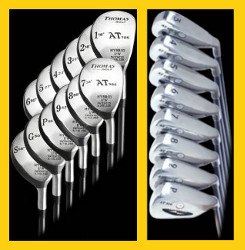
Long Irons
In the game of golf, long irons play a crucial role in a golfer's bag. They are numbered irons typically ranging from 2 to 4 and are designed to hit the ball at longer distances with a lower trajectory compared to higher-numbered irons or clubs like woods. Let's delve into the world of long irons and understand their characteristics and usage.
- Loft: Long irons have less loft compared to other irons. The 2-iron usually has a loft of around 18-20 degrees, while the 3-iron is around 21-24 degrees, and the 4-iron is approximately 25-28 degrees. The lower loft generates less spin and a flatter trajectory, allowing the ball to carry further through the air.
- Length: Long irons are longer in length than their higher-numbered counterparts. The extra length, combined with less loft, helps increase the distance a golfer can hit the ball. However, the longer club length also makes it slightly more difficult to control compared to shorter irons.
- Shot trajectory: Long irons are designed to produce a lower ball flight compared to woods or hybrids. This lower trajectory helps golfers in certain situations, such as hitting under or through tree branches or when facing strong winds. The lower trajectory also aids in achieving greater roll upon landing.
- Distance: Long irons are primarily used for their distance capabilities. Skilled golfers can hit long irons off the tee or fairway to cover significant distances. These clubs are helpful when you need to reach a long par-5 in two shots or hit a long approach into a green.
- Difficulty: Long irons are known for being more challenging to hit consistently compared to higher-numbered irons or hybrids. This difficulty mainly stems from the combination of their length, lower loft, and smaller clubhead size. As a result, many golfers, especially beginners or high handicappers, opt for using fairway woods or hybrids instead of long irons.
When using long irons, it's important to keep a few key points in mind:
- Ball position: Place the ball slightly forward in your stance compared to mid-irons or short irons. This helps ensure a clean strike and assists in achieving the desired trajectory.
- Swing smoothly: Long irons require a smooth and controlled swing. Avoid trying to over-hit the ball, as it can lead to inconsistent contact and loss of accuracy.
- Clubhead speed: Generating enough clubhead speed is crucial when using long irons. Ensure a full and smooth weight transfer during the swing to maximize distance.
- Consider alternatives: If you struggle with long irons or find them challenging to hit consistently, consider using hybrids or fairway woods as alternatives. These clubs have similar distance capabilities but are generally more forgiving and easier to hit.
By understanding the characteristics and proper usage of long irons, you can leverage them effectively to improve your performance on the golf course. With practice and patience, these clubs can become valuable weapons in your golf bag, allowing you to tackle long distances with confidence!
- How Can I Improve My Long Irons?
- Correct Golf Answer: Make sure your long irons are appropriate for your handicap and focus on achieving a great set up and connection with the ball.
- How Can I improve my Long Irons? Video – by Pete Styles
- Why Are Hybrid Golf Clubs Different From Long Irons Video – by Peter Finch





